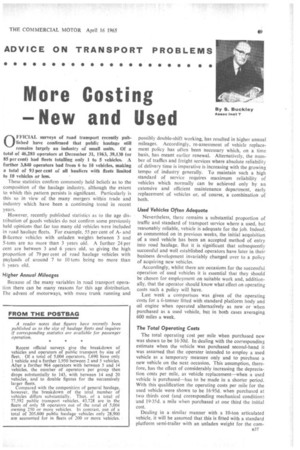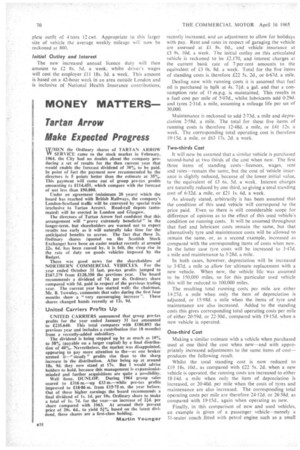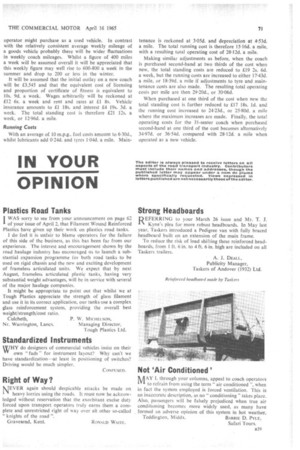More Costing New and Used
Page 71

Page 72

Page 73

If you've noticed an error in this article please click here to report it so we can fix it.
By S. Buckley
Assoc Ins* T
OFFICIAL surveys of road transport recently published have confirmed that public haulage still remains largely an industry of small units. Of a total of 46,289 operators at December 31, 1963, 39,130 (or 85 per cent) had fleets totalling only 1 to 5 vehicles. A further 3,840 operators had from 6 to 10 vehicles, making a total of 93 per cent of all hauliers with fleets limited to 10 vehicles or less.
These statistics confirm commonly held beliefs as to the composition of the haulage industry, although the extent to which this pattern persists is significant. Particularly is this so in view of the many mergers within trade and industry which have been a continuing trend in recent years.
However, recently published statistics as to the age distribution of goods vehicles do not confirm some previously held opinions that far too many old vehicles were included in road haulage fleets. For example, 55 per cent of Aand B-licence vehicles with unladen weights between 3 and 5-tons are no more than 3 years old, A further 24 per cent are between 3 and 6 years old, so giving the high proportion of 79 per cent of road haulage vehicles with payloads of around 7 to 10 tons being no more than 5 years old.
Higher Annual Mileages Because of the many variables in road transport opera. Lion there can be many reasons for this age distribution. The advent of motorways, with more trunk running and possibly double-shift working, has resulted in higher annual mileages. Accordingly, re-assessment of vehicle replacement policy has often been necessary which, on a time basis, has meant earlier renewal. Alternatively, the number of traffics and freight services where absolute reliability of delivery time is imperative is increasing with the growing tempo of industry generally. To maintain such a high standard of service requires maximum reliability of vehicles which normally can be achieved only by an extensive and efficient maintenance department, early replacement of vehicles or, of course, a combination of both.
Used Vehicles Often Adequate Nevertheless, there remains a substantial proportion of traffic and standard of transport service where a used, but reasonably reliable, vehicle is adequate for the job. Indeed, as commented on in previous weeks, the initial acquisition of a used vehicle has been an accepted method of entry into road haulage, But it is significant that subsequently successful and well established operators have later in their business development invariably changed over to a policy of acquiring new vehicles.
Accordingly, whilst there are occasions for the successful operation of used vehicles it is essential that they should be chosen for employment on suitable work and, additionally, that the operator should know what effect on operating costs such a policy will have.
Last week a comparison was given of the operating costs for a 6-tonner fitted with standard platform body and oil engine when operated alternatively as new or when purchased as a used vehicle, but in both cases averaging 600 miles a week.
The Total Operating Costs The total operating cost per mile when purchased new was shown to be 16.30d. In dealing with the corresponding estimate when the vehicle was purchased second-hand it was assumed that the operater intended to employ a used vehicle as a temporary measure only and to purchase a new vehicle on the next occasion. This assumption, therefore, has the effect of considerably increasing the depreciation costs per mile, as vehicle replacement—when a used vehicle is purchased—has to be made in a shorter period. With this qualification the operating costs per mile for the used vehicle were shown to be 16.95d. when purchased at two thirds cost (and corresponding mechanical condition) and 19-35d. a mile when purchased at one third the initial cost.
Dealing in a similar manner with a 10-ton articulated vehicle, it will be assumed that this is fitted with a standard platform semi-trailer with an unladen weight for the corn plete outfit of 4 tons 12 cwt. Appropriate to this larger size of vehicle the average weekly mileage will now be reckoned at 800.
Initial Outlay and Interest The new increased annual licence duty will then amount to £2 8s. 5d. a week, whilst driver's wages will cost the employer £11 18s. 3d. a week. This amount is based on a 42-hour week in an area outside London and is inclusive of National Health Insurance contributions, recently increased, and an adjustment to allow for holidays with pay. Rent and rates in respect of garaging the vehicle are assessed at fl 8s. Od., and vehicle insurance at £3 9s. 10d. a week. The initial outlay on this articulated vehicle is reckoned to be £2.170, and interest charges at the current bank rate of 7 per cent amounts to the equivalent of £3 Os. 8d. a week. Total for the five items of standing costs is therefore £22 5s. 2d., or 6.67d. a mile.
Dealing now with running costs it is assumed that fuel oil is purchased in bulk at 4s. 74d. a gal. and that a consumption rate of 11 m.p.g. is maintained. This results in a fuel cost per mile of 5.07d., whilst lubricants add 0.29d. and tyres 2.31d. a mile, assuming a mileage life per set of 30,000.
Maintenance is reckoned to add 2.73d. a mile and depreciation 2.58d. a mile. The total for these five items of running costs is therefore 12-48d. a mile, or £41 12s. a week. The corresponding total operating cost is therefore 19-15d. a mile, or £63 17s. 2d. a week.
Two-thirds Cost
It will now be assumed that a similar vehicle is purchased second-hand at two thirds of the cost when new. The first three items of standing costs-licences, wages, rent and rates-remain the same, but the cost of vehicle insurance is slightly reduced, because of the lower initial value, to the equivalent of £3 6s. 5d. a week. Interest charges are naturally reduced by one third, so giving a total standing cost of 6.32d. a mile, or £21 Is. 6d. a week.
As already stated, arbitrarily it has been assumed that the condition of this used vehicle will correspond to the price paid. Even so there is still considerable scope for difference of opinion as to the effect of this used vehicle's condition on running costs. It will be assumed throughout that fuel and lubricant costs remain the same, but that alternatively tyre and maintenance costs will be allowed to remain the same, or, as a second example, increased as compared with the corresponding items of costs when new. In the latter case tyre costs will be increased to 3.47d. a mile and maintenance to 3-28d. a mile.
In both cases, however, depreciation will be increased to 3-87d. a mile to allow for ultimate replacement with a new vehicle. When new, the vehicle life was assumed to be 150,000 miles, so for this particular used vehicle this will be reduced to 100,000 miles.
The resulting total running costs per mile are either 14.27d. a mile when only the item of depreciation is adjusted, or 15.98d. a mile when the items of tyre and maintenance are also increased. Added to the standing costs this gives corresponding total operating costs per mile of either 20.59d. or 22-30d., compared with 19.15d. when a new vehicle is operated.
One-third Cost
Making a similar estimate with a vehicle when purchased used at one third the cost when new-and with appropriately increased adjustments to the same items of costproduces the following result.
Whilst the total standing cost is now reduced to £19 18s. 10d., as compared with £22 5s. 2d. when a new vehicle is operated, the running costs are increased to either 18.14d. a mile when only the item of depreciation is increased, or 20.40d. per mile when the costs of tyres and maintenance are also increased. The corresponding total operating costs per mile are therefore 24.12d. or 26.38d. as compared with 19.15d., again when operating as new.
Finally, in this comparison of new and used vehicles, an example is given of a passenger vehicle-namely a 31-seater coach .fitted with petrol engine such as a small
operator might purchase as a used vehicle. In contrast with the relatively consistent average weekly mileage of a goods vehicle probably there will be wider fluctuations in weekly coach mileages. Whilst a figure of 400 miles a week will be assumed overall it will be appreciated that this weekly figure may well rise to 600-800 a week in the summer and drop to 200 or less in the winter.
It will be assumed that the initial outlay on a new coach will be £3,545 and that the equivalent cost of licensing and proportion of certificate of fitness is equivalent to 10s. 9d. a week. Wages arbitrarily will be reckoned at £12 6s. a week and rent and rates at £1 8s. Vehicle insurance amounts to £1 18s. and interest £4 19s. 3d. a week. The total standing cost is therefore £21 12s. a week, or 12-96d. a mile.
Running Costs
With an average of 10 m.p.g., fuel costs amount to 6.30d., whilst lubricants add 0.24d. and tyres 1.044. a mile. Main tenance is reckoned at 3.05d. and depreciation at 4.53d. a mile. The total running cost is therefore 1516d. a mile, with a resulting total operating cost of 2812d. a mile.
Making similar adjustments as before, when the coach is purchased second-hand at two thirds of the cost when new, the total standing costs are reduced to £19 2s. 6d. a week, but the running costs are increased to either 17.43d. a mile, or 18.39d. a mile if adjustments to tyre and maintenance costs are also made. The resulting total operating costs per mile are then 29.20d., or 30.06d.
When purchased at one third of the cost when new the total standing cost is further reduced to £17 18s. ld. and the running cost increased to 24-23d., or 25-80d. a mile where the maximum increases are made. Finally, the total operating costs for the 31-seater coach when purchased second-hand at one third of the cost becomes alternatively 34.97d. or 36.54d. compared with 28.12d. a mile when operated as a new vehicle.




















































































































